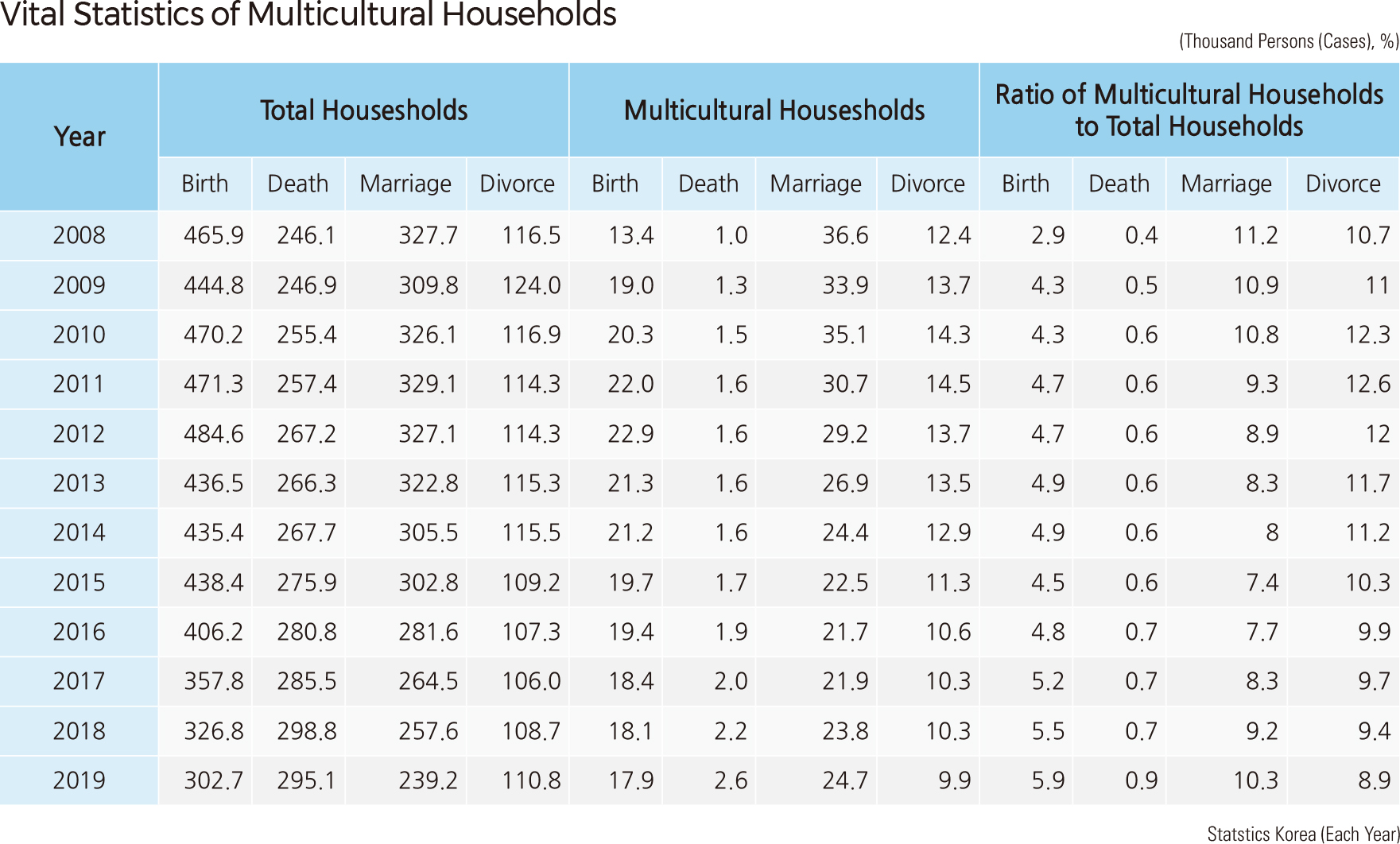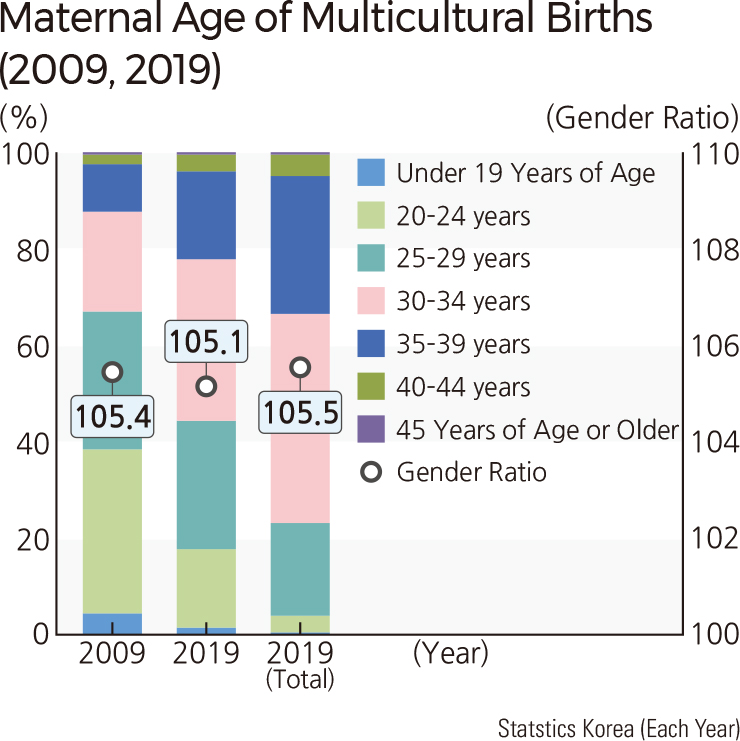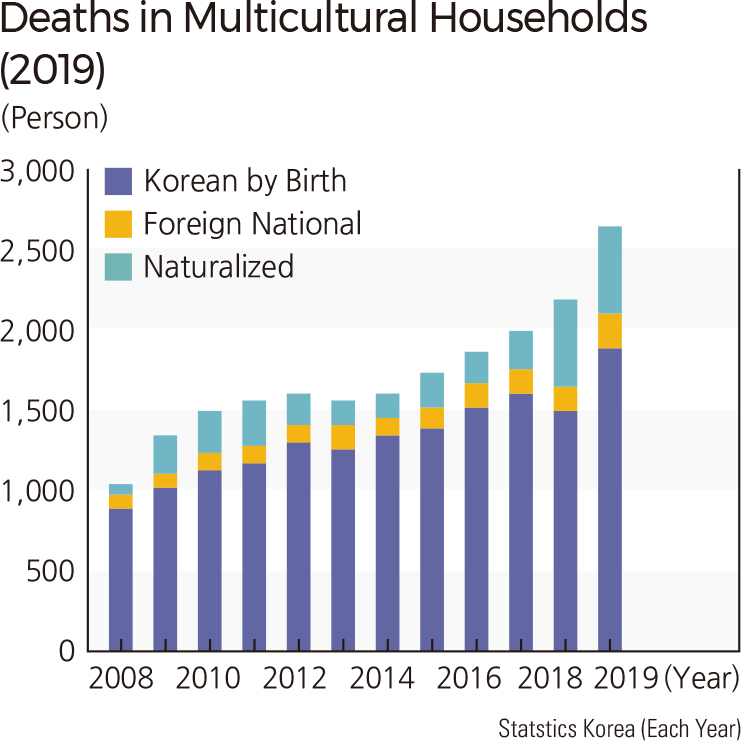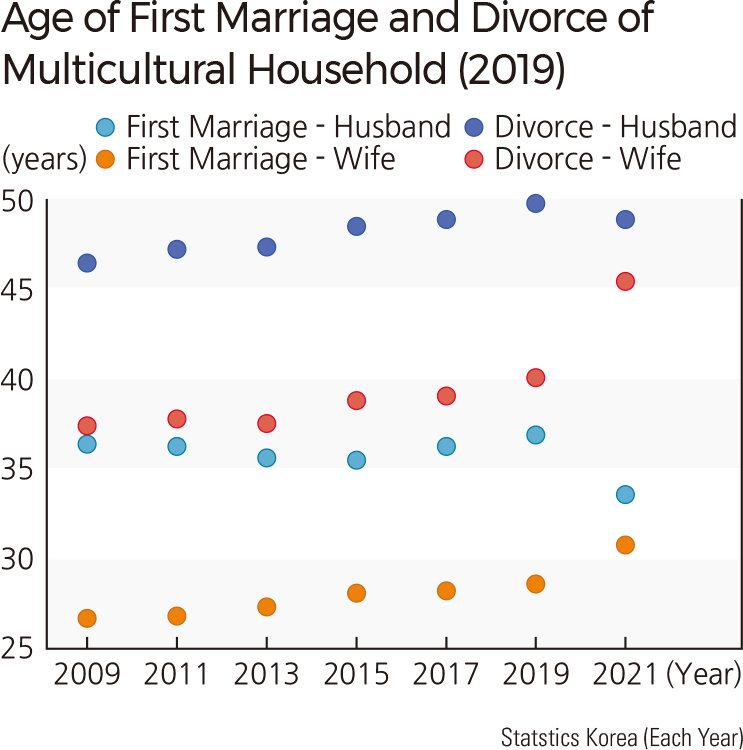English III 2021
Vital statistics of multicultural households show the demographic importance of multicultural households in the demographic dynamics of Korea. The vital statistics of multicultural households show similar demographic change with a decrease in births and an increase in deaths, likewise the vital statistics of Korea. However, the proportion of multicultural households in the vital statistics of Korea is increasing. Multicultural marriages and divorces account for approximately 10% of all marriages and divorces. Since the mid-2010s, the number of births in multicultural households has decreased due to the decline in the number of multicultural marriages. However, the proportion of births in multicultural households has continuously increased due to the steeper decline in the total number of births in Korea. As a result, the proportion of births in multicultural families increased from 2.9% in 2008 to 5.9% in 2019. The proportion of deaths in multicultural households to the total death rate is low, but both the number and proportion of deaths are increasing due to the growth of multicultural households. The marriage of multicultural households declined until 2016, but it has recently risen. As of 2019, international marriage accounted for 10.5% of all marriages. The divorce rates of multicultural households were the highest around 2010 and have declined since then. Divorces in multicultural households account for 8.9% of all divorces. Births in multicultural households can be divided into births from foreign mothers, foreign fathers, and naturalized foreign residents by marriage. Compared to 2009, the number of births of naturalized foreign residents by marriage increased in 2019. It is because marriage immigrants became naturalized foreign residents by marriage. The age range that accounts for the largest proportion of mothers of children born in multicultural households in 2009 was between the ages of 20 and 24. In 2019, the age range became between 30 and 34, indicating that the maternal age had increased. Nevertheless, in 2019, the maternal age of multicultural households was lower than the maternal age of all households. The male-to-female sex ratio of all the newborns of multicultural households was not significantly different from that of all households. In 2019, there were 55 -si/-gun/-gu areas where the ratio of the newborns of multicultural households to the total newborns exceeded 10%, including Geumcheon-gu in Seoul, Ansan-si and Siheung-si in Gyeonggi-do, and rural districts in other provinces. By province, Gyeonggi-do had the highest number of newborns among multicultural households, followed by Seoul, Gyeongsangnam-do, and Incheon. Jeollabuk-do had the highest proportion of newborns of multicultural households (8.1%) compared to the total number of newborns. Regarding the deaths in multicultural households, Koreans accounted for the largest number, and the number of naturalized foreign residents by marriage was rapidly increasing. In 2019, the ratio of foreign wives and Korean husbands was the highest at 69.3%, followed by foreign husbands and Korean wives at 17.2%, and either husband or wife was a naturalized foreign resident or both were naturalized foreign residents at 13.5%. There were 48 -si/-gun/-gu areas where the ratio of the marriages of multicultural households to total marriages exceeded 15%. Their distribution is similar to that of regions with a high ratio of newborns in multicultural households. By province, Gyeonggi-do had the highest number of multicultural marriages, followed by Seoul and Incheon. On the other hand, Jeju Special Self-Governing Province (13.2%) had the highest proportion of multicultural marriages, followed by Jeollanam-do (11.8%), Chungcheongnam-do (11.8%), and Jeollabuk-do (11.2%). The age of first marriage for foreign wives was 28.4 years, which is 2.2 years lower than that for all wives, at 30.6 years. However, the age for first marriage for foreign wives is continuously increasing. On the contrary, the age of first marriage for husbands of multicultural marriages is higher than that for all husbands. The country with the highest percentage of a husband’s nationality in multicultural marriages is Korea, followed by China, the United States, and Vietnam. The percentage of Japanese husbands in multicultural marriages decreased significantly compared to 2009. In multicultural marriages, Vietnam has the highest percentage of wives’ nationality, followed by Korea and China. Among Southeastern Asian countries, the countries with the highest percentage of wives’ nationality were Vietnam, the Philippines, and Cambodia in that order in 2009, but as of 2019, Vietnam, Thai, and the Philippines were in that order. In 2019, the ratio of divorce in multicultural households was 47.1% for foreign wives, 37.3% for either husband or wife being a naturalized foreign resident or both being naturalized foreign residents, and 15.6% for foreign husbands. The age of divorce for multicultural households is increasing for both men and women. The country with the highest percentage of husbands’ nationality in divorces for multicultural households was Korea, followed by China, Japan, and the United States. The countries with the highest percentage of wives’ nationalities were China, Vietnam, and the Philippines, in that order. |







